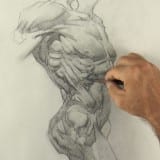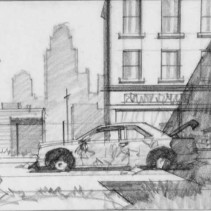Portrait & Figure Artist Learning Path
Something to keep in mind…
These learning paths outline different “years” of training. The general breakdown assumes that a student can complete a phase in about one month. Keep in mind that this is the optimal state of progression, and that many of us who already have a day job or other responsibilities may have a difficult time keeping this pace up. These learning paths are a general outline for our curriculum, so apply it to your own life, goals and allotted time for art.
First Year
The first year of your training at Watts Atelier will consist of foundational drawing. A heavy emphasis will be placed on constructive drawing, comparative measurement and use of the Reilly abstraction.
The idea for the first year is to be doing a lot of “starts” of drawings. We will not be getting into finishing drawings in the first year, though you will practice some rendered/shaded efforts.
Check the Course Previews Page to see a video description on each class.
Course list, from left to right:
- Drawing Fundamentals Phase I
- Drawing Fundamentals Phase II
- Head Drawing Fundamentals
- Figure Drawing Fundamentals
- Quicksketch Fundamentals
- Structural Figure Drawing
- Head Phase I – Layins and Structure
- Figure Phase I – Mannequinization
- Head Phase II – Casts and Photos
- Figure Phase II – 20m Layins
- Head Phase III
- Figure Phase III – Figure Quicksketch
Second Year
The second year will focus on introducing you to painting. Starting with basic Gouache and oil painting in the monochrome and Zorn palette. The second year will also introduce you into more complex and finessed drawing with a focus on good proportions, values and edgework. As you move into the later section of this year you’ll be working more on master studies and gestures.












Check the Course Previews Page to see a video description on each class.
Course list, from left to right:
- Gouache Phase I
- Gouache Phase II
- Head Drawing Phase IV
- Figure Drawing Phase IV
- Oil Painting Fundamentals
- Portrait Phase I
- Gouache Phase III
- Figure Painting Phase I
- Portrait Phase II
- Figure Painting Phase II
- Portrait Painting Phase III
- Figure Painting Phase III
Third Year
The third year will start to uncover advanced learning. After getting a lot of your straight fundamentals out of the way, you can start to explore more specialty classes. You should at this point have the knowledge needed to continue your own advanced learning on your own, continuing to nurture your own growth and development as an artist. As someone who will specialize in portrait and figure, you will need to grind A LOT of that. The level of expertise required to be a high level portrait and figure artist requires a lot of practice. This doesn’t mean that you shouldn’t delve into other areas such as landscape, still life and more. Have fun practicing!










Check the Course Previews Page to see a video description on each class.
Course list, from left to right:
- Portrait Phase IV
- Drapery
- Head Drawing Phase V
- Figure Drawing Phase V
- Figure Painting Phase IV
- Features and Facial Expressions
- Bridgman Anatomy Phase I: Torso
- Anatomy Intensives: Arms and Legs
- Anatomy Intensives: Torso
- Composition and Staging
A Note to Students:
While these learning paths have been charted to best help students in their chosen disciplines, they are by no means the only path to learning. Students are free to view their lessons and courses in any order they so wish.
















